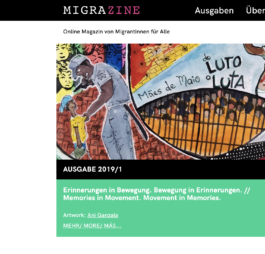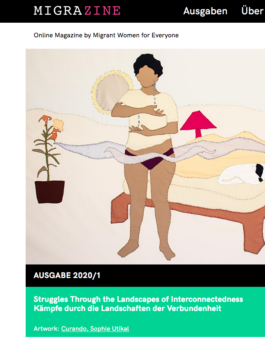MIGRAZINE
Struggles Through the Landscapes of Interconnectedness
It is not news that everything on the planet is interconnected. We have been warned many times about the consequences of global warming and the future spread of new viruses and bacteria. For hundreds of years, voices of wisdom have taught us about symbiosis, the intertwined lives of species, and about the ecological network, in which there are no borders or autonomy of a certain species.
The current issue of the Corona virus and the state of exception across the world is an example that shows the reality of interconnectedness on a global scale. Not only because of the spreading of this infection throughout territories, but also because it has brought forth new relations to space and migration. At the same time, we have been witnessing new hierarchies, based on old structures of racism, unfolding, and also, despite Covid-19, the emergence of new anti-racist solidarities, such as the current global protests surrounding the Black Lives Matter movement.
As human-animals that have moved through territories since forever we have been constantly exposed to new sceneries. These processes of migrating have meant encountering and reformulating the connections we have with landscapes and natural spaces. The expropriation, exploitation, and destruction of land, the reorganization of landscapes, and climate change are all closely related to processes of migration, either within or beyond a certain territory. In the context of the neo-liberal, neo-colonial world we live in today, with its enormous concentration of people in big cities, with wars for oil and other resources, entire communities have been affected, and in many cases they have been forced to leave their homelands and seek refuge.
However, we know that not everyone has the possibility (and often the privilege) to migrate. So, which struggles in Europe are in dialogue with those happening in the Global South? And how do these dialogues and politics of interconnectedness contribute to the changes for a flourishing earth and life on a damaged planet?
Ezgi Erol, Lia Kastiyo-Spinósa & Ivana Marjanović
Editorial 2019/1
Memories in Movement. Movement in Memories
Movement of people is also a movement of stories and memories, individual and collective, conditioned by the context of specific remembrance politics. Stories are private, political and are also related to social movements, to more or less organized ways of political lives of people in the past and the present. Traveling stories and memories have the potential to enrich our imagination and inspire action, keep us going, give us strength, drive our actions.
Migrazine 2019/1 issue deals with the conveying and processing of migrant experiences in the context of remembrance discourses. The topic of migrated stories and remembrance cultures in the global era is examined on the basis of terms such as discourse, power, and action, and an anti-racist counter-narrative in the migration society is brought to the fore. In this way, a contribution is made to the delegitimization of racist violence in the current context of right-wing populism.
What are the stories that “can’t” be forgotten, which ones must not be forgotten, which are slipping or falling into oblivion and why, and why is it important that we talk about them?
In 2019, maiz also celebrated its 25-year anniversary! 25 years of struggles for the rights of migrant women and youth, also through means of deploying critical migrant voices in the media. At this point, Migrazine also asks: What does maiz remember and what is important to fight for? What inspires maiz?
Remembrance can also be horrifying, what to do and how in the context of a constant state of war on the planet?
Ezgi Erol, Lia Kastiyo-Spinósa & Ivana Marjanović

Forensic Body, Songül Sönmez
Forensic Body
von Ezgi Erol
Interview mit Songül Sönmez
Fünf Haarzöpfe sind installiert in fünf Glasröhren. Festgebunden vom Boden bis zur Decke mit einem dünnen Stahldraht. Durch die in einem Labor-Setting integrierte Soundinstallationen erfahren wir forensische Geschichten von fünf Mädchen und Frauen, die im Zuge der von der Türkei verhängten Ausgangssperren 20151 ermordet worden sind. Die Arbeit Forensic Body von der Künstlerin Songül Sönmez wurde für die Ausstellung Krieg kuratieren 2018 angefertigt. Sönmez‘ Arbeit bringt die gerichtsmedizinische Vorgehensweise mit den Leichen dieser fünf Frauen während des Krieges in die Ausstellung ein, und thematisiert und reflektiert die vom türkischen Staat über die Körper von Mädchen und Frauen ausgeübte Gewalt.

MIGRAZINE
Struggles Through the Landscapes of Interconnectedness
It is not news that everything on the planet is interconnected. We have been warned many times about the consequences of global warming and the future spread of new viruses and bacteria. For hundreds of years, voices of wisdom have taught us about symbiosis, the intertwined lives of species, and about the ecological network, in which there are no borders or autonomy of a certain species.
The current issue of the Corona virus and the state of exception across the world is an example that shows the reality of interconnectedness on a global scale. Not only because of the spreading of this infection throughout territories, but also because it has brought forth new relations to space and migration. At the same time, we have been witnessing new hierarchies, based on old structures of racism, unfolding, and also, despite Covid-19, the emergence of new anti-racist solidarities, such as the current global protests surrounding the Black Lives Matter movement.
As human-animals that have moved through territories since forever we have been constantly exposed to new sceneries. These processes of migrating have meant encountering and reformulating the connections we have with landscapes and natural spaces. The expropriation, exploitation, and destruction of land, the reorganization of landscapes, and climate change are all closely related to processes of migration, either within or beyond a certain territory. In the context of the neo-liberal, neo-colonial world we live in today, with its enormous concentration of people in big cities, with wars for oil and other resources, entire communities have been affected, and in many cases they have been forced to leave their homelands and seek refuge.
However, we know that not everyone has the possibility (and often the privilege) to migrate. So, which struggles in Europe are in dialogue with those happening in the Global South? And how do these dialogues and politics of interconnectedness contribute to the changes for a flourishing earth and life on a damaged planet?
Ezgi Erol, Lia Kastiyo-Spinósa & Ivana Marjanović
Editorial 2019/1
Memories in Movement. Movement in Memories
Movement of people is also a movement of stories and memories, individual and collective, conditioned by the context of specific remembrance politics. Stories are private, political and are also related to social movements, to more or less organized ways of political lives of people in the past and the present. Traveling stories and memories have the potential to enrich our imagination and inspire action, keep us going, give us strength, drive our actions.
Migrazine 2019/1 issue deals with the conveying and processing of migrant experiences in the context of remembrance discourses. The topic of migrated stories and remembrance cultures in the global era is examined on the basis of terms such as discourse, power, and action, and an anti-racist counter-narrative in the migration society is brought to the fore. In this way, a contribution is made to the delegitimization of racist violence in the current context of right-wing populism.
What are the stories that “can’t” be forgotten, which ones must not be forgotten, which are slipping or falling into oblivion and why, and why is it important that we talk about them?
In 2019, maiz also celebrated its 25-year anniversary! 25 years of struggles for the rights of migrant women and youth, also through means of deploying critical migrant voices in the media. At this point, Migrazine also asks: What does maiz remember and what is important to fight for? What inspires maiz?
Remembrance can also be horrifying, what to do and how in the context of a constant state of war on the planet?
Ezgi Erol, Lia Kastiyo-Spinósa & Ivana Marjanović

Forensic Body, Songül Sönmez
Forensic Body
von Ezgi Erol
Interview mit Songül Sönmez
Fünf Haarzöpfe sind installiert in fünf Glasröhren. Festgebunden vom Boden bis zur Decke mit einem dünnen Stahldraht. Durch die in einem Labor-Setting integrierte Soundinstallationen erfahren wir forensische Geschichten von fünf Mädchen und Frauen, die im Zuge der von der Türkei verhängten Ausgangssperren 20151 ermordet worden sind. Die Arbeit Forensic Body von der Künstlerin Songül Sönmez wurde für die Ausstellung Krieg kuratieren 2018 angefertigt. Sönmez‘ Arbeit bringt die gerichtsmedizinische Vorgehensweise mit den Leichen dieser fünf Frauen während des Krieges in die Ausstellung ein, und thematisiert und reflektiert die vom türkischen Staat über die Körper von Mädchen und Frauen ausgeübte Gewalt.



